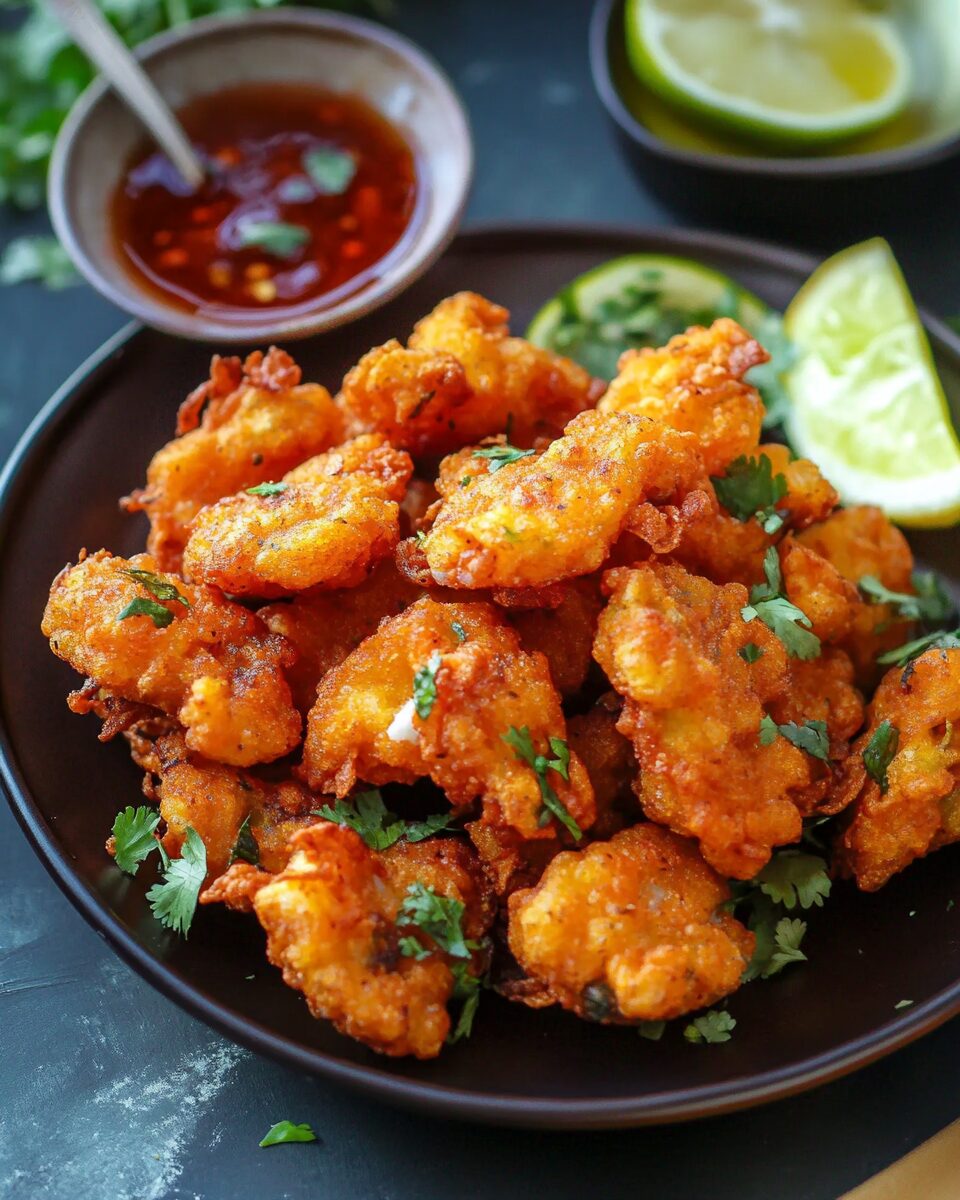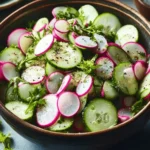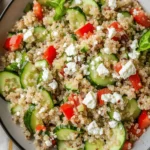Fish Pakora is a delicious, crispy, and flavorful appetizer that brings the rich taste of South Asian cuisine to your table. Made by coating fish fillets in a spiced chickpea flour batter and deep-frying them to perfection, this dish is perfect for serving as a starter or snack.
FULL RECIPE
Ingredients
- Fresh fish fillets
- Chickpea flour (besan)
- Rice flour
- Baking soda
- Lemon juice
- Ginger-garlic paste
- Green chilies
- Fresh cilantro
- Red chili powder
- Turmeric powder
- Ground cumin
- Ground coriander
- Garam masala
- Salt
- Water
- Oil (for frying)
Directions
- Cut the fish fillets into bite-sized pieces and pat them dry with paper towels.
- In a large mixing bowl, combine chickpea flour, rice flour, and baking soda.
- Add the ginger-garlic paste, chopped green chilies, and fresh cilantro.
- Season the mixture with red chili powder, turmeric powder, ground cumin, ground coriander, garam masala, and salt.
- Squeeze in fresh lemon juice and gradually add water to create a thick, smooth batter.
- Heat oil in a deep fryer or a large pot over medium-high heat.
- Dip each fish piece into the batter, ensuring it is well coated.
- Carefully lower the fish into the hot oil and fry until golden brown and crispy.
- Remove the fried fish pakoras using a slotted spoon and place them on paper towels to drain excess oil.
- Serve hot with mint chutney, tamarind sauce, or a side of lemon wedges.
Nutrition Facts
- Calories: 250 kcal
- Protein: 20g
- Fat: 10g
- Carbohydrates: 20g
- Fiber: 2g
- Sodium: 400mg
Flavor Profile and Texture
Fish Pakora is known for its crispy exterior and succulent interior, offering a perfect balance of texture and flavor. The chickpea flour used in the batter adds a nutty essence while also ensuring a crunchy bite. The combination of spices infuses the fish with aromatic warmth, and the ginger-garlic paste provides a savory, slightly pungent note that enhances the overall taste. The lemon juice adds a hint of citrusy brightness that cuts through the richness of the fried fish.
Cultural Significance
Fish Pakora holds a cherished place in South Asian cuisine, particularly in regions like Punjab and coastal areas where seafood is abundant. It is commonly prepared during festive gatherings, family events, and celebrations. Often served alongside green chutney or tamarind sauce, Fish Pakora is a staple appetizer that reflects the vibrant culinary traditions of the region. The dish is also popular at street food stalls, where its irresistible aroma draws crowds.
Serving Suggestions
Fish Pakora pairs well with a variety of dips and sides. Fresh mint chutney, yogurt-based raita, or tangy tamarind sauce complement the crispy fish perfectly. For a complete meal, it can be served with fragrant basmati rice or a simple cucumber salad. Additionally, a squeeze of lemon and a sprinkle of chaat masala can elevate the flavors, providing a zesty kick.
Health Considerations
While Fish Pakora is a fried dish, it can still be enjoyed in moderation as part of a balanced diet. The use of chickpea flour offers a gluten-free alternative, making it suitable for those with gluten sensitivities. Fish is also a great source of lean protein and omega-3 fatty acids, contributing to heart and brain health. To make a lighter version, consider air frying or baking the pakoras instead of deep frying.
Cooking Tips
For the best results, ensure the oil is heated to the right temperature before frying. Maintaining a temperature of around 350°F (175°C) will result in a crispy, golden crust without excessive oil absorption. Additionally, using a slotted spoon to remove the pakoras allows excess oil to drain, keeping them light and crispy. Patting the fish fillets dry before coating them in the batter will also help the batter adhere better.
Historical Background
Fish Pakora traces its roots back to South Asia, where pakoras have long been a popular snack across India, Pakistan, and Bangladesh. Originating from ancient culinary traditions, the concept of frying spiced ingredients in chickpea flour batter has evolved over centuries. While vegetable pakoras are common, the use of fish in this dish is a regional adaptation that showcases the availability of fresh seafood in coastal areas. The dish has since gained international popularity, becoming a beloved appetizer in Indian restaurants worldwide.
Popular Accompaniments
A traditional plate of Fish Pakora is often paired with various condiments that enhance its flavors. Mint chutney, made with fresh mint, cilantro, green chilies, and lemon juice, is a refreshing contrast to the deep-fried texture. Tamarind chutney offers a sweet and tangy twist, balancing the spiciness of the pakora. Yogurt-based raita, seasoned with roasted cumin and mint, provides a cooling element that complements the dish.
Beverage Pairings
Fish Pakora is often enjoyed with beverages that complement its bold flavors. A chilled glass of mango lassi provides a creamy and sweet contrast to the spiced pakoras. Alternatively, a glass of masala chai with its rich blend of spices can enhance the savory notes of the dish. For a refreshing option, a glass of freshly squeezed lemonade or a cooling mint cooler works well to balance the heat from the spices.
Role in Modern Cuisine
While traditional Fish Pakora remains a popular choice, chefs and home cooks are continually experimenting with modern twists. Fusion variations might include using panko breadcrumbs for an extra crispy texture or incorporating exotic spices like smoked paprika or sumac. Some contemporary versions are served as fish pakora tacos or paired with gourmet aioli sauces, reflecting the dish’s adaptability across global cuisines.
Sustainability Considerations
When preparing Fish Pakora, choosing sustainable fish options can reduce the environmental impact. Opting for species certified by sustainable seafood programs ensures that fish populations are maintained responsibly. Popular sustainable choices include tilapia, cod, or haddock. Supporting local fisheries also helps promote ethical sourcing practices and reduces carbon footprints.
Seasonal Influence
The best time to enjoy Fish Pakora is when fresh, local fish are in season. Coastal regions offer a variety of seasonal fish, allowing for fresher and more flavorful pakoras. Pairing the dish with seasonal herbs like cilantro and mint or enjoying it with summer beverages like lemonade makes for a refreshing experience. Seasonal vegetables can also be added to the batter for added texture and taste.
Family and Community Tradition
Fish Pakora is often a communal dish, prepared during family gatherings or festive occasions. The process of frying pakoras together fosters a sense of togetherness and joy. In many households, it is a traditional snack served during the monsoon season, with families gathering to enjoy the crispy bites while watching the rain. This cultural bonding experience adds sentimental value to the dish.
Conclusion
Fish Pakora is a delicious and versatile dish that brings together bold flavors and satisfying textures. Whether served as an appetizer at a festive gathering or enjoyed as a quick snack, it remains a beloved staple in South Asian cuisine. With its customizable spice levels and various serving options, Fish Pakora is sure to please any palate. Its golden, crispy exterior and tender fish interior make it an irresistible addition to any menu. By experimenting with different dipping sauces and spice variations, you can create a personalized version of this classic dish that perfectly suits your taste preferences.






